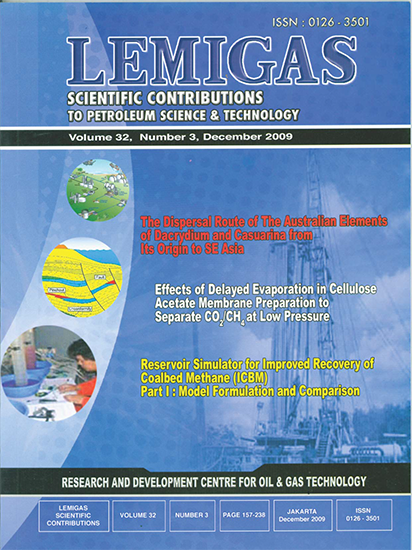Surfactant Utilization In Oil Sludge Biode Gradation Using Slurry Bioreactor
DOI:
https://doi.org/10.29017/SCOG.32.3.851Keywords:
Nonionic surfactant, oil sludge, biodegradation, bioavailability, slurry bioreactorAbstract
Oil sludge from petroleum industry effluent is classified as hazardous waste and requiredspecial treatment before discharge to the environment. Biodegradation using bacterialactivities is a general treatment for oil sludge processing. However, the bacterial abilityin oil sludge biodegradation is blocked by non-aqueous phase liquid of oil sludge. Twopossible ways of enhancing the bioavailability of oil sludge are surfactants application and slurry bioreactors system. The objective of this study is to obtain the surfactant which can increase oil sludge biodegradation using simple slurry bioreactor. The surfactant selection obtained Emulsogen LP (58% effectiveness) which was examined based on HLB value, nonionic character, and surfactant effectiveness. Emulsogen LP is readily biodegradable which reached 93% biodegradability in 15 days. The biodegradation test showed that Emulsogen LP addition on its Critical Micelle Concentration (10 mg/L) enhanced oil sludge biodegradation in 3 bacterial cultures of Pseudomonas aeruginosa, Bacillus subtilis, and Actinobacter baumanni after 48 hours. By surfactant addition, oil sludge biodegradation reached 37-49% whereas without surfactant addition it only reached 28-33%. The highest oil sludge biodegradation was obtained in P. aeruginosa cultures with Emulsogen LP addition (49%). The surfactant addition had no effect on microbial growth. Moreover, P. aeruginosa population was increased by surfactant addition.
References
Soriano, AU and N Pereira Jr. 2002. Oily sludge
biotreatment. In: IPEC & CESE (Eds.). 9th Annual
International Petroleum Environmental Conference.
Albuquerque, New Mexico.
Rahman, KSM. G Street, R Lord, G Kane, TJ
Rahman, R Marchant, and IM Banat. 2006.
Bioremediation of petroleum sludge using bacterial
consortium with Biosurfactant. In: SN Singh
& RD Tripathi (eds). Environmental
Bioremediation Technologies. Springer Publication.
p: 391-408
Mohan, SV. M Ramakrishna, S Shailaja, and PN
Sarma. 2007. Influence of Soil-Water Ratio on
the Performance of Slurry Phase Bioreactor
Treating Herbicide Contaminated Soil.
Bioresource Technology 98: 2584-2589.
Machin-Ramirez, C. AI Okoh, D. Morales, K.
Mayolo-Deloisa, R. Quintero, MR. trejo-
Hernandez. 2008. Slurry-phase biodegradation of
weathered oily sludge waste. J. Chemosphere
(2008): 737-744.
Volkering, F. AM Breure, and WH Rulkens. 1998.
Microbiological aspects of surfactant use for biological
soil remediation. J. Biodegradation 8: 401-
Volkering, F. et.al., 1995. Influence of nonionic
surfactants on bioavailability and biodegradation
of polycyclic aromatic hydrocarbon. Applied and
Environmental Microbiology. vol. 61 (5): 1699-
Zheng, Z. and JP Obbard. 2001. Effect of nonionic
surfactant on biodegradation of polycyclic
aromatic hydrocarbon (PAHs) in soil by
Phanerochaete chrysosporum. J.Chem. Technol.
Biotechnol. 76: 423-429
McClement, DJ. 1999. Food emulsion: principles,
practice, and techniques. 2nd ed. CRC Press.
Boca Raton. 104, 108 pp.
Cristofi, N. and IB Ivshina. 2002. A review: Microbial
surfactants and their use in field studies
of soil remediation. J. Appl. Microbiology. 93: 915-
Aronstein, BN. YM Calvillo, and M Alexander.
Effect of surfactants at low concentrations
on the desorption and biodegradation of sorbed
aromatic compounds in soil. Environ. Sci.
Technol. vol. 25 (10): 1728-1731
Downloads
Issue
Section
License
Copyright (c) 1970 SCIENTIFIC CONTRIBUTIONS OIL AND GAS (SCOG)

This work is licensed under a Creative Commons Attribution 4.0 International License.
Authors are free to Share — copy and redistribute the material in any medium or format for any purpose, even commercially Adapt — remix, transform, and build upon the material for any purpose, even commercially.
The licensor cannot revoke these freedoms as long as you follow the license terms, under the following terms Attribution — You must give appropriate credit , provide a link to the license, and indicate if changes were made . You may do so in any reasonable manner, but not in any way that suggests the licensor endorses you or your use.
No additional restrictions — You may not apply legal terms or technological measures that legally restrict others from doing anything the license permits.














